| Botanical Name |
|
| Family |
Aizoaceae - The fig-marigold family or ice plant family |
| Pronunciation |
|
| Common Name(s) |
English: Ice plant; Mesem
|
| Plant Group |
- Ground Cover A plant with a low-growing, spreading habit, grown specifically to cover the ground.
- Perennial A plant whose life cycle lasts for three or more seasons.
- Succulent A plant having fleshy stems or leaves often adapted to dry conditions.
|
| Plant Size |
- Small to Medium
| Tree | 8m to 15m |
| Shrub | 75cm to 1m |
| Perennial/ground cover | 20cm to 40cm |
| Bulb | 30cm to 40cm |
| Succulent | 20cm to 40cm |
|
| Position |
- Sun The area is in full sun for all or most of the day, all year round.
|
| General Information |
- Drought Tolerance: High The plant is well adapted to arid conditions; it can survive long periods of drought and high temperatures without extra water.
- Evergreen Plants that have leaves all year round.
- Frost: Half-hardy The plant is able to survive low temperatures and some frost but requires protection against severe frost.
- Prune hard after flowering Fast growing shrubs that grow lanky within a season. Cut off branches and stems of these plants to a third of their original length. This will increase the yield of flowers, improve the plants shape and enhance the structural strength of main branches.
- Salt spray tolerant A plant with specific adaptations enabling it to grow in a saline environment.
- Sand tolerant Plants adapted to survive in nutrient poor, very sandy soils.
- Water Wise Plant species originating from low rainfall regions that require less water to survive and thrive than other plant species.
- Wind Tolerant Plants able to withstand the effect of strong winds.
|
| Specific Information |
There are over a hundred varieties of Lampranthus and many of them are valued as garden plants. Usually relegated to the rockery or succulent garden, these plants are far more versatile and can be incorporated in most areas of the garden, where their lustrous blossoms will enhance their surroundings. Lampranthus species have smooth, three-angled leaves, and the group varies from an upright, bushy growth habit to lax, cascading or creeping ground covers. Some bushes extend to a meter across. They are not suited to areas with high humidity and rainfall.
|
| Ad Break |
|
| Flowers |
| Description |
daisy-like flowers with a silky sheen on the petals
|
| Season |
- Spring to Summer Plants will seldom bloom for the entire season as given in the list, but should flower during a period within these parameters.
|
| Colour |
- red
- pink
- white
- orange
- yellow
- mauve
- purple
- magenta
|
| Growth Rate |
- Fast Specifying growth rate can be very misleading as there is considerable variation of growth rate depending on type and species of plant, available water, supplementary feeding, mulching and general care, as well as the plants suitability and adaptability to the garden environment.
|
| Plant Uses |
- Attracts bees, butterflies or other insects This plant attracts insects which can be food for birds or other creatures in your garden.
- Border A strip of ground, at the edge of a driveway or path in which ornamental plants or shrubs are planted.
- Container Trees, shrubs and ornamental species that can adapt to growing in a restricted environment.
- Edging A low growing plant that provides softness or definition to the edges of a bed or walkway.
- Filler Either a fast growing tree or shrub used temporarily to fill in an area while the permanent plants grow to a desired size, or a plant used to fill gaps in borders or beds.
- Ground Cover Low-lying plants that spread fast, require minimal maintenance, and cover large expanses or bare areas between bulbs or shrubs. They provide protection from erosion and drought and improve the visual appearance of the garden.
- Interplanting Arranging and planting plants in the garden that have different blooming times and habits of growth, extending the amount of time in which the area is in flower.
- Mass Planting Plants useful for filling a large area with just one or a few kinds of plants spaced close together. Creates a bold, dramatic effect and to reduces maintenance.
- Pioneer for new gardens A very fast growing plant, able to withstand hardship, that can be used to populate land that has recently been cleared of natural vegetation. These plants pave the way for slower-growing species by adding nutrients to the soil and creating leaf litter.
- Pot Plant A plant that needs a protected environment on a patio or indoors.
- Retaining Walls Shallow rooted plants for cascading over dry stone walls or planting in hollow spots in retaining blocks.
- Rock Garden An area constructed of larger rocks, arranged naturally, to emphasise the use of stones as a main element. Generally plants used do not need a lot of care.
- Stabilize Banks Plant is used to prevent soil erosion because their roots will form a mat that stabilizes the soil and keeps it from washing away in heavy rains.
- Suitable for coastal gardens Plants adapted to dry, sandy soil, forceful wind, limited rainfall and intense sunlight.
- Suitable for seaside gardens Plants that will survive the hostile environment of harsh salty winds, dry sandy soil, irregular rainfall and heat found in seaside gardens.
- Wild Garden An indigenous garden planted for the benefit of wildlife and birds. Provides food, water, a variety of mini-biomes and no poisonous chemicals are used.
|
| Distribution and Habitat |
predominantly in the Western Cape, Northern Cape and southern Namibia, with some species in the Eastern Cape, mainly in the drier winter rainfall regions, on coastal sand dunes, sandy flats, slopes, rocky outcrops and karoo veld
|
| Planting Suggestions |
Vygies need a sunny, well-drained position and very little watering, too much water causing them to rot. Rockeries and north or west-facing slopes are best. Vygies thrive in most soil types, and need little nourishment. They seldom, if ever, need feeding, which causes an overgrowth of soft, lax stems. Water moderately from autumn to spring. Once established, the plants need little water except during very long, dry periods. The plants tend to get untidy and can be pruned to shape after flowering. These plants have a short lifespan and should be replaced with cuttings every second or third year. They are easy to propagate with cuttings planted straight into the ground. Perennial vygies can be planted at any time of the year but avoid making cuttings during the flowering period.
|
| Medicinal Uses |
|
| Ad Break |
|


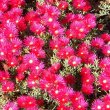
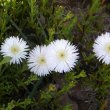
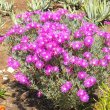
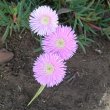

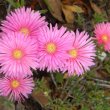
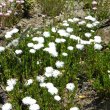
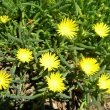
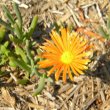


Comments
vygies
Hi there,
I have seen in my neigbour's garden that the vygie's rotted during our wet winter in Cape Town and nothing else grows where the vygie's were. Friends have warned me of this phenomenon and urged me to take my vygies out. I did quite a big mass planting of vygies. And now I'm worried that the whole area will be dead to any plants next winter. Do you have any experience with this?
Thank you for your help
Claudia
Hi Claudia
Hi Claudia
I am afraid that I can be of no help here. I have never heard of this happening before and have not experienced it myself. I have removed vygies many times and replanted the areas with other plant species without a sign of the problem you have mentioned.
Does this occur only where the vygies have previously rotted, or generally anywhere that vygies have previously been planted?
Would it perhaps be possible to contact someone and the Kirstenbosch Botanical Gardens with this query. They must have experience with growing vygies in Cape Town, and may be better able to give you accurate advice.
Do keep in touch and let me know if you have been able to solve this puzzle.
Kind regards
Lorraine
vygies
Thank you, Lorraine.
Yes, the problem seems to occur when the plants have rotted. I have decided to simply remove any rotting plants in winter and replant later. Vygies grow so fast anyway. I hope this will solve the problem.
Vygies
Good idea. One way to prevent rotting is to make a mound of soil and plant a vygie on top of it. This will allow greater run-off and keep the roots drier. As you say, vygies grow so quickly and in my garden I seldom let them grow for longer than two seasons before I pull them out and start over.
I set my cuttings in autumn so that as soon as flowering is over in spring, I have small plants ready to take the place of the older ones. This way they have time to grow big enough to make a good show the following spring.
I do hope you are able to keep your plants. They make such a dazzling sight.
Will vygies grow under large trees
Please assist me. I wish to plant vygies on my pavement. It has a number of large trees. I have previously had problems with getting grass to grow due to the lack of sun.
Thank you.
Vygies in shade
Hi Bernadette
Vygies in general do not thrive in shade. They become leggy and soft, and flowering is greatly reduced. I have also found that vygies I experimented with in shady positions are very prone to attacks of scale and disease. You don't mention where you are so it is a bit difficult to make alternative suggestions.
Do please let me know the area in which you live and your water situation so that I can give you an appropriate list of plants you can use.
Kind regards
Lorraine
vygies luise
It seems as if my vygies may have lice. White balls all over the plant. It also stopped flowering. What can I do?
Discuss this plant
Share knowledge, ask a question or give an experience.